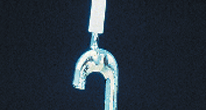chillysalsa
Headphoneus Supremus
- Joined
- Sep 26, 2002
- Posts
- 1,989
- Likes
- 187
Solder is a temperature that will undergo creep at room temperature. This is a process that is active whenever a mechanical stress is imposed typically at temperatures 0.4 of the melting point.
For solder, room temperature corresponds to about 0.65 of it's melting point (455ºK) on the Kelvin scale, which is why creep behavior is a consideration.
Even when the stress or loading is small, solder may easily deform over time. This can lead to solder joints failing over time. This is why it is advised that through-hole components be mechanically clinched and why connections to wiring should be looped, for example like those on hooked or eyelet terminals:

From the NASA soldering specs, click more examples.
Sidenote: Surface mount components are unique in that only the solder is holding them onto the board and supporting the loads, and thus these components must be small and designed to prevent differences in thermal expansion to cause stress that will shorten component life.
Just something people shoulder remember from a workmanship standpoint. I recall taking the J-standard soldering coarse at an aerospace company, and some people's concerns about proper assembly and workmanship.
For solder, room temperature corresponds to about 0.65 of it's melting point (455ºK) on the Kelvin scale, which is why creep behavior is a consideration.
Even when the stress or loading is small, solder may easily deform over time. This can lead to solder joints failing over time. This is why it is advised that through-hole components be mechanically clinched and why connections to wiring should be looped, for example like those on hooked or eyelet terminals:

From the NASA soldering specs, click more examples.
Sidenote: Surface mount components are unique in that only the solder is holding them onto the board and supporting the loads, and thus these components must be small and designed to prevent differences in thermal expansion to cause stress that will shorten component life.
Just something people shoulder remember from a workmanship standpoint. I recall taking the J-standard soldering coarse at an aerospace company, and some people's concerns about proper assembly and workmanship.

